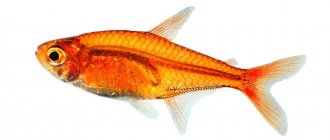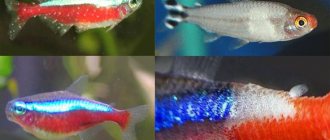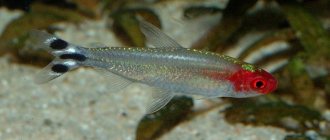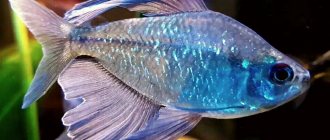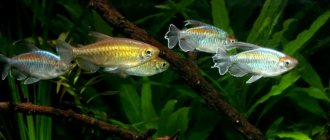These fish come from Brazil, in particular, their habitat is the Aritsuanan River. I would like to immediately note that Kerry Inpaichts are very unpretentious, and therefore are an ideal option for beginner aquarists and other lovers of home aquariums.
Slender light bluish males are amazingly beautiful; as a rule, they are slimmer than females and shimmer with bluish shades when reflected light hits them. Their terminal anal fin is presented in the form of a rounded shape.
Female Kerry Inpaichts have a more rounded abdomen and are colored yellow-brown. The anal fin of females appears pointed at the end.
Also, one of the differences between males and females of Kerry inpaichts can be confidently attributed to their adipose fin. Males have a bluish fin, while in females it is mixed with reddish colors.
In aquarium conditions, these fish reach a length of up to five centimeters and live for approximately four years.
Peace-loving Kerry Inpaichts keep in packs, and therefore it is better to keep them in numbers of at least six to eight pieces. In schools, fish feel much more comfortable, look great and become less timid.
Range and Habitat
South America: Aripuanan River, upper Madeira River Basin, Mato Grosso, Brazil.
Mainly inhabits forest areas of slow-flowing tributaries of the main river channel.
The water in these biotopes is often brown in color due to tannins/tannins and other chemicals released from decaying organic materials, resulting in very acidic water.
Feeding
In nature, Kerry tetras are micropredators that actively eat small crustaceans floating in the water, invertebrates and insects that have fallen into the water.
In captivity, fish are completely unpretentious in terms of nutrition and actively eat everything that is offered to them. You can feed lilac neons with various types of live and frozen food. They also eat dry flake food quite well.
The main thing is that the food does not immediately fall to the bottom, but sinks slowly, since due to the anatomical structure of the jaws it is difficult for animals to pick up food from the bottom.
Description
The Purple Imperial Tetra is a brilliant violet-blue color. The translucent ventral, anal and caudal fins are colored yellow, while their dorsal fins are colored in varying shades of red.
Males and females differ in color; the male's dorsal fin is elongated and the adipose fin is blue. The remaining fins are transparent, but the pectoral and anal fins are also a shade of blue. The back is light blue to purple. A wide iridescent/iridescent dark blue stripe extends from the snout through the eye to the caudal fin. Below the stripe the color is pale blue until the belly where the color changes to beige.
The female also has an elongated dorsal fin, but the adipose fin is reddish in color. It has a broad black line instead of blue, and the area above it is beige with a silvery-blue tint in reflected light. The belly is white and sometimes has a silvery sheen.
Now a breeding form of the Kerry tetra has appeared on sale - Inpaichthys kerri “Super Blue”.
Size
Maximum standard length 3.5 cm.
TETRA KERRY DISEASE
The Kerry tetra disease was most similar to that caused by the bacteria Flexibacter columnaris. This pathogenic organism is not scary for strong individuals, but overcrowding and poor maintenance contribute to its massive development.
Considering the speed of manifestation of the disease, one must think that the fish brought this disease with them. After 2-3 days, ulcers and saprolegnia (a secondary fungal disease that occurs on dead tissue) appeared in place of the white spots.
Photo of Kerry tetra sex marker
In addition to clean, fresh, daily-changed water, I used medications in the recommended doses: Biseptol, Bactopur and Mycopur (SERA), but I was unable to overcome the disease, and the bulk of the super blue kerries died by the middle of the second month.
Attempts to keep infected fish separately did not help either. Three specimens survived, having lost all mating interest by that time, most likely due to the consequences of the disease.
In this sad story, however, there is a bright and at the same time somewhat mysterious and incomprehensible page. Kerry, refusing to spawn in randomly selected pairs, already on the third day began to spawn in a flock and continued to spawn, not paying attention to the disease, literally “to the last”! The “fighters” dropped out one after another, meanwhile, every evening I collected 30-50 eggs from under the bars, of which, unfortunately, only about 10% survived. Either it was the disease that affected the parents, or it was a sign of the obviously general degeneration of the species due to its mutation.
It was obvious that all the fish that arrived from Germany would gradually die, and one could only hope that they would have time to create a new home school. The incomprehensible thing about this story was that the surviving fry did not perceive their parents’ illness in any way, showed a good appetite and grew at a normal speed.
Signs of coloring appeared at one month of age in the form of a black longitudinal stripe. Since the entire spawning period lasted for 1.5 months, fry of different ages were raised together, and they had to be fed taking into account their size, but in general the main food was Artemia nauplii with the addition of home-bred brackish water rotifers and slipper ciliates.
Aquarium
A small group of these fish will require an aquarium measuring about 60*40*30 cm and a volume of 70 liters or more. Organizing an aquarium biotope is very simple. Use river sand substrate and add some driftwood, branches and twisted roots.
A few handfuls of dry leaves (beech or oak leaves can be used) will complete the creation of a natural biotope. Aquatic plants are not a characteristic feature of natural waters in habitats. Driftwood and leaves will turn the water the color of weak tea, remove old leaves and replace them every few weeks to prevent them from decomposing and contaminating the water.
A small mesh bag filled with peat can be added to the filter, or use peat concentrate to help simulate natural conditions - creating black water. Use fairly dim lighting.
An alternative biotope in which Inpaichthys kerri will thrive is an aquarium densely planted with aquarium plants with free places for swimming.
Water parameters:
Temperature: 24-27° C pH: 5.5-7.0 Hardness: 1-12° DGH
It is advisable to avoid alkaline conditions.
Spawning of Tetra Kerry
In the epic with blue kerry tetras, as you can see, I used schooling prolonged spawning, when the pair is not selected by the aquarist, but is formed randomly by fish ready for spawning.
The conditions for such spawning of the Kerry tetra depend on the size of the spawning flock. For “volley” (paired) spawning, a small container of 10-12 liters can be used; this space is usually enough for breeders, but given that a good female can lay more than 350 eggs (I have not observed this in super blue kerries) and if the outcome is favorable, in this case only 30 ml of water will be needed per fry, then it is better to take a breeder more.
Photo of a juvenile Kerry tetra
As a spawning substrate, Kerry needs bushes of small-leaved plants (or moss), squeezing through the thickets of which, characins spawn eggs in portions of 3-10 pieces. Spawning water: 0.5°dGH, 0.4-0.5°dKH, pH 6.2-6.8 at a temperature of 26-28°C.
The blue kerry tetra spawns at any time of the day, but most often in the very early hours, in low light. The spawners planted in the evening spawn the next day or the next day.
According to my observations, in calm water spawning occurs with difficulty or fails altogether, while intense blowing provokes it: Kerry likes to feel the flow of water, which makes them move. To create a flow, you can place a low-power, approximately 2 W, water pump at the bottom and direct its flow along the bottom.
When the Kerry tetra spawns in a common aquarium as part of a flock, the leading male takes a comfortable position near a small-leaved bush or a voluminous tuft of moss and waits for a ready female, energetically driving away competitors. Of course, the water in the container must correspond to spawning parameters, and a protective mesh must be placed at the bottom.
Obviously, it is not necessary to wait until the end of spawning, but simply at the end of the day, use a siphon tube to collect the laid eggs from under the grate, and at the same time the accumulated debris. As a last resort, the eggs can be sucked directly through the grate without lifting it. Then select healthy eggs from the sludge (through the light) and transfer them to a separate container with water from the spawning tank.
Hatching occurs 18 hours after spawning, and after 98-122 hours the larvae enter the juvenile stage and begin to feed.
Kerry tetras
during spawning they lay very small eggs, and the hatching larva is also very miniature: the diameter of the egg is 0.95 mm, the length of the newborn at the moment of emergence from the shell is 1.7 mm.
The situation is saved by the unusually rapid growth of the fry: before they begin swimming, they manage to almost double in size due to the yolk sac. These rates will continue. Under favorable conditions, the maturity of ordinary kerries occurs after four months. Their super blue relatives also mature at the same time.
Feeding juvenile Kerry tetras is not difficult; a fish that has started swimming after a day of taking starter food (ciliates, rotifers, cyclops larva) is capable of swallowing even an Artemia nauplius. Juvenile Kerry are inactive, hiding in the vegetation until color appears, then their activity increases and the fry rise to the upper layers.
Photo of blue tetra kerry
Nursing the fry has no special features. And the endurance of young carries is indirectly confirmed by the following fact, told to me by V. Miloslavsky, to whom, as usual, I handed over the fish to prepare illustrations for this article.
This time the subjects of photography were a pair of breeders I had selected and several Kerry larvae. At the end of the shooting, Vladimir returned the “waste material” to me, and then drained the water from the container in which the fish were located during the photo session, almost to the ground level, turning off, of course, the heating pad and the lamp.
When, a month later, the vessel was needed to photograph the next batch of fish, it contained an almost centimeter-long, completely healthy fry, which thus successfully withstood the temperature changes inevitable in such conditions (it was spring with its unstable weather) and a meager diet, consisting exclusively of a self-reproducing population of benthic microorganisms, and even forced to make do not with open water, but with miserable puddles remaining in the gravel pits.
I. VANYUSHIN Mytishchi, Moscow region.
Aquarium Magazine 2010 No. 5
Kerry or False Royal Tetra (Inpaichthys kerri)
Gery & Junk, 1977
Other names: Tetra Kerry, Purple Imperial Tetra.
Behavior and Compatibility
The Kerry or False King Tetra is a small, peaceful species of aquarium fish that will not compete with more active/aggressive or larger tankmates. Ideally, they should be kept with other South American species, which may include small tetras, nanostomuses, cuneiforms, Apistograma or other dwarf cichlids and peaceful bottom dwellers such as corydoras and otocinclus. It will also coexist well with small gouramis, rasboras and peaceful barbs.
They have a slightly undeserved reputation as fin-biting fish. Although this kind of behavior tends to occur when they are kept in insufficient quantities. If a group of half a dozen is acquired, any aggression is usually limited to within that flock. And the larger/denser this school is, the definitely much better these fish feel in it and the more interesting their behavior and brighter their coloring.
Breeding
They are regularly bred in captivity. You will need to get a separate tank as a spawning tank if you want to raise a decent number of fry. Something about 45*25*25 cm in size for a group of fish and a little smaller for a pair.
This container should be very dimly lit, since the eggs and juveniles of this species are sensitive to light. Add clumps of small-leaved plants such as Java moss or artificial spawning sponges to give the fish a place to lay their eggs.
Alternatively, you could cover the base/bottom of the spawning tank with some kind of mesh. The size of the mesh should be large enough so that the eggs can pass through, but small enough that the producers cannot reach them. Peat filtration is a useful addition since reverse osmosis water will be used.
A small sponge air filter with little bubbling is all that is needed from a filtration standpoint.
Water parameters in the spawning aquarium:
The water should be soft and acidic in the pH range 5.5-6.5, Gh 1-5, at a temperature of about 25-28° C.
Spawning can occur in a group of half a dozen individuals of each sex to be more efficient.
Alternatively, spawning may take place in pairs. When using this method, groups of males and females are kept in separate aquariums. When the females noticeably gain eggs and the males acquire a bright color, choose the best breeders from them (the fuller females and the brightest and most active males); it is better to place them in the spawning aquarium in the evening. They usually spawn the next morning.
In any case, the spawners eat the eggs and must be removed immediately after spawning. The larvae hatch after 24-48 hours, the fry begin to swim freely after 3-4 days. For the first few days, usually 10-12 days, ciliates are used as a starter feed until the fry are large enough to accept nematodes or brine shrimp nauplii.
Life expectancy is 3-5 years, depending on the conditions of detention.
Water
The acidity of the medium should be between 6 and 7. Strongly acidic or basic pH
inhibits the vital activity of living organisms.
The temperature must be maintained at 23 degrees with a maximum error of 1 degree.
The water hardness should be kept at about 5. It is better here without errors. Rigidity
depends on the chemical composition of the liquid. Although fish and plants are more sensitive to
acid-base pH indicator.
To independently create the necessary physical and chemical parameters of water for
your pets, you need to spend a lot of time studying a solid list
literature. It’s easier to entrust this to our specialists.
Notes
Quite a few different species of aquarium fish can be seen for sale with the same name, including the "king" tetra. Palmeri or King tetra (Nematobrycon palmeri) is sometimes confused with Kerry or false king tetra (Inpaichthys kerri), but they can be easily distinguished from each other, Kerry has an adipose fin, while all Nematobrycon species do not.
The genus Inpaichthys is currently monophyletic (containing only one species), as are some other fishes associated with the family, such as Hifessobriconus; its taxonomic status is Incertae SEDIS, meaning uncertain. It is therefore possible that I. Kerri will be reclassified at some point in the future.


